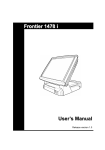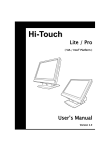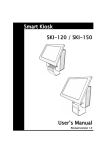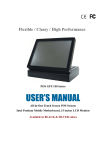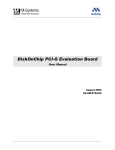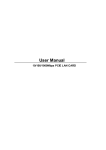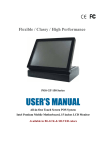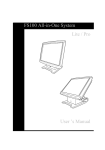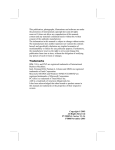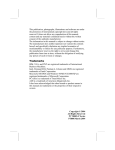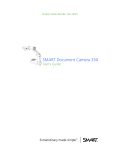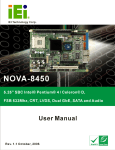Download Frontier_1478 i_UM_EN_v1.0
Transcript
User ’s Manual Release version 2.0 Preface About this Manual Thank you for purchasing our ONE-POS Touch Terminal. This terminal offers highly enhanced features, with easy connection to various optional devices for optimal performance. This user manual describes how to setup and connect your terminal. Copyright © Copyright 2007 All rights reserved. This product and related documentation are protected by copyright and are distributed under licenses restricting their use, copying, and distribution. No part of this documentation may be reproduced in any form by any means without prior written authorization of the manufacturer and its licensors, if any. Safety notices Before You Proceed • Read the safety notices and the User’s Manual carefully before using the product. • Keep the box and packaging in case the product needs to be shipped in the future. • Follow the product and warning label instructions. • Any changes or modifications that do not follow the instructions in this manual will void this product's warranty. Power Supply Safety Notes • To avoid electric shocks, disconnect the power cord from the electrical outlet before relocating the system. • Make sure the voltage of the power outlet conforms within voltage range of the terminal. Failure to comply may cause the electric shock or damage to the terminal. If you are not sure of the electricity voltage that you are using, consult your local electricity company. • To avoid fire or electric shocks, do not overload electric power outlets. • Protect the power cord from being walked on or pinched particularly at plug, convenience receptacles, and the point where they exit from the apparatus. i Preface Operating Instructions • Keep this manual for future reference. • Keep this equipment from moisture and dust. • Place the equipment on a stable surface before setting it up. • If there is any of the following situation arise, notify a qualified service technician immediately: ¾ The power cord or plug is damaged. ¾ Liquid has been spilt on to the equipment. ¾ The equipment has been dropped and damaged. ¾ The equipment does not function normally. • Do not block any ventilation openings to prevent the equipment from overheat. • Do not leave the equipment in a non air-conditioned environment where the storage temperature may go above 70°C (158°F), as this can cause damage to the equipment. Maintenance • Gently wipe screen with a clean soft hair lens brush, or a lint-free cloth. • Do not apply pressure to the screen while cleaning. • Do not spray any liquid directly onto the screen or the casing of the ONE-POS Terminal. • Chemical cleaners have been reported to cause damage on the screen of the ONE-POS Terminal. Warning and Attention • The technical descriptions and specifications of the equipment are subject to change without notice. • For safety reasons, wear gloves when assembling the product. Caution • Risk of explosion battery is replaced by an incorrect type. Dispose of used batteries according to the instructions. ii Preface Federal Communications (FCC Statement) This device complies with FCC Rules Part 15. Operation is subject to the following two conditions: • This device may not cause harmful interference. • This device must accept any interference received including interference that may cause undesirable operation. This equipment has been tested and found to comply within the limit of a Class A digital device, pursuant to Part 15 of the FCC Rules. These limits are designed to provide reasonable protection against harmful interference in a residential installation. This equipment generates, uses and can radiate radio frequency energy and, if not installed and used in accordance with the manufacturer’s instructions, may cause harmful interference to radio communications. However, there is no guarantee that interference will not occur in a particular installation. If this equipment does cause harmful interference to radio or television reception, which can be determined by switching the equipment on and off, the user is encouraged to try to correct the interference by one or more of the following measures: • Reorient or relocate the interference receiving antenna. • Increase the distance of separation between the equipment and interference receiver. • Connect the equipment to a power outlet on a circuit different from that to which the interference receiver is connected. • Consult the dealer or an experienced radio/TV technician for help. WARNING: The use of shielded cables for connection of the monitor to the graphics card is required to assure compliance with FCC regulations. Changes or modifications to this unit not expressly approved by the party responsible for compliance could void the user’s authority to operate this equipment. iii Content CHAPTER 1 ................................................................................................1 WELCOME ..................................................................................................1 OVERVIEW OF ONE-POS...................................................................1 FRONT VIEW .......................................................................................2 REAR VIEW .........................................................................................2 OSD CONTROL BUTTONS ....................................................................3 FEATURES ..........................................................................................4 UNPACKING ........................................................................................5 CHAPTER 2 ................................................................................................6 GETTING STARTED...................................................................................6 PRE-INSTALLTION..............................................................................6 DEFAULT SETTING ...............................................................................6 REAR I/O JUMPER SETTING ..................................................................7 MAIN BOARD JUMPER SETTING .............................................................8 LIMITATIONS ........................................................................................9 HARDWARE INSTALLATION ............................................................ 10 INSTALLING THE POWER CORD AND INTERNET CABLE ............................. 10 INSTALLING THE CUSTOMER DISPLAY................................................... 11 INSTALLING THE 2ND LCD DISPLAY (OPTIONAL) .................................... 13 INSTALLING THE MSR ADAPTER BRACKET (OPTIONAL) .......................... 14 INSTALLING THE MSR (OPTIONAL) ....................................................... 15 LCD OPERATION ANGLE ................................................................. 15 INSTALLING AN FILTER AND CLEANING THE FANS..................... 16 HARD DISK DRIVE REPLACEMENT ................................................ 17 APPENDIX ................................................................................................ 18 TECHNICAL INFORMATION .................................................................... 18 SPECIFICATIONS .......................................................................... 18 FREQUENTLY ASKED QUESTIONS (FAQ).................................. 20 iv Chapter 1 Chapter 1 Welcome Congratulations on your purchase of this POS terminal. Your easy-to-use POS terminal is designed to help you enhance your business flexibility by offering a superior customer experience. Overview of ONE-POS Model ONE-POS CPU Intel P4 2.8 GHz / Intel Celeron 2.5 GHz / Intel Celeron D 2.8GHz Chipset HDD Intel 852GME + ICH4 2.5” / 3.5 “ x 1 Storage devices CF memory card DOM (Disk On Module) uDOC (USB Disk On Chip) Serial Port Total 6 (Touch & MSR I/F included) USB port Total 6 (USB Ver. 2.0) Powered USB 2 (1 x 12V/ 1 x 24V) DC Output for peripherals DC 12V & DC 24V plug 1 Chapter 1 — Welcome The figures below illustrate the components (including input and output ports) located at the front and rear views of ONE-POS. Front View DESCRIPTION 1 2 3 4 5 6 7 8 9 Slim type CD-ROM PS/2 Mouse port CF Card slot Reset button Power button Mic In USB port x 2 Key lock LED indicators (From top to bottom: HDD, LAN, Power, 5V SB) Rear View DESCRIPTION 1 AC in 90 to 264V full range 2 3 4 5 6 LPT for POS Printer COM 3 COM 4 COM 1 DC 24V for POS Printer DC 12V for 2nd LCD PS/2 POS K/B port 10/100 Base T LAN Port 2nd VGA Port Powered USB 2.0 +12V Powered USB 2.0 +24V 7 8 9 10 11 12 2 Chapter 1 — Welcome OSD Control Buttons ICON 1 Power LED 2 Brightness + 3 Brightness – 4 Speaker + 5 Speaker – FUNCTION Red: Standby mode. Green: System start up. Press the “Brightness +” and “Brightness –” buttons for brightness adjustment. The setting will be saved after releasing the button for 6 seconds. Press the “Speaker +” and “Speaker –” buttons for volume adjustment. The setting will be saved after releasing the button for 6 seconds. Note: Press the “Brightness –” and “Speaker +” at the same time to restore the factory default setting. 3 Chapter 1 — Welcome Features This POS terminal comes equipped with the following features: Fan speed control • The low noise design of the fan speed control for ONE-POS is ideal for noise-intolerant environment such as retail store and restaurant, etc. Patented HeatPipe cooling solution • Unique HeatPipe cooling solution is designed for efficient and effective system cooling in high temperature environments. Saving cost of ownership • Modular design provides the owner with the following benefits: (a) cost effectiveness, (b) customization flexibility, and (c) easy maintenance. Compact size/ Aesthetic design • Slimmest in the POS industry standard (24 mm). This elegant, economic POS system features a sleek, compact design base that saves counter space and adds appeal to the service environment. Dust/waterproof • ONE-POS features a highly durable, rigorously tested design that is reliable and dependable in rugged environments. WEPOS/XPE solution • Solution is recommended to be bundled with embedded solution for high performance and other added values. Environment protection • Environmental friendly, RoHS compliant product. Higher stability • The ONE-POS has a longer overall system MTBF and provides higher stability during operation. 4 Chapter 1 — Welcome Unpacking Before setting up your ONE-POS, check that the package contains the following items. If any of the items is missing or damaged, contact your vendor immediately. ONE-POS Touch Terminal Customer Display (optional) 2nd LCD Customer Display (optional) AC Power Cord Magnetic Stripe Reader (optional) Filter Cover (optional) Air Filter (optional) Accessory Package 1. Driver CD disc 2. User’s Manual 3. Front Door Key 4. DC24V power cable 5. P.E. sheet 6. Spare screws 5 Chapter 2 Chapter 2 Getting Started This chapter describes how to install the optional accessories on your ONE-POS Touch Terminal for optimal serviceability. Pre-installation Notice Before you start installing your ONE-POS, please read the following notices carefully. 1. ONE-POS does not support PCI slot. 2. Do not plug in or unplug any interior devices, such as memory module or any function card, when the ATX PSU is powered on. 3. If using the ONE-POS in a dusty environment, clean the fan and cooler regularly. Alternatively, protect your system by using a filter, which should also be replaced at regular intervals. 4. For installation and compatibility, using the DDR RAM Module from the original manufacturer is recommended. 5. The USB device connector is Hot Swap capable. Do not plug in or unplug any connector except USB devices when the power is on. 6. The spill proof design of ONE-POS conforms to IP-43 standard. 7. Do not insert or remove any device or component from the ONE-POS while the power is on. Default Setting Default settings for ONE-POS Touch Terminal serial ports COM1 COM2 COM3 COM4 COM 5 COM 6 3F8 2F8 3E8 2E8 4F8 4E8 IRQ 4 IRQ 3 IRQ 4 IRQ 3 IRQ 5 IRQ 10 6 Chapter 2 — Getting Started Preset voltage setting for MSR 1. The MSR default setting is ISO Track 1 & 2. (For customized track settings, advise the manufacturer before production.) 2. In event of any requirement to change the setting of the MSR, run Setting utility in the driver CD provided in the accessory package. 3. The normal swiping card speed of the MSR is 10 to 100 cm/sec. (based on the ISO 7812 standard). Rear I/O Jumper Setting J1 COM1/ J3 COM3/ J4 COM4 Voltage Select Pin 5-6 closed Normal (COM1 / COM4 default) Pin 3-4 closed +5V (COM3 default for RS232 Customer Display) Pin 1-2 closed +12V Note: Please refer to page 17 for HDD bracket release. 7 Chapter 2 — Getting Started Main Board Jumper Setting J4 COM5 Voltage Select Pin 1-2 closed +5V (default) Pin 2-3 closed +12V J5 COM5 Function Select Pin 1-2 closed Normal (default) Pin 2-3 closed +5V or +12V for RS232 MSR or other RS232 device JP1 CMOS Clear Jumper Off Default Jumper On CMOS clear 8 Chapter 2 — Getting Started Limitations Connector with Voltage Output COM 1 for extension interface (9th PIN of DB-9) COM 2 for Touch Panel interface COM 3 for extension interface (9th PIN of DB-9) COM 4 for extension interface (9th PIN of DB-9) COM 5 for extension interface COM 6 for Cash Drawer driving DC 12V Powered USB for peripherals DC 24V Powered USB for peripherals *2nd LCD Monitor Power Connector (DC Plug) *DC 24V Printer Power Connector (Hosiden 3PIN) Location Average current Pack current Bottom side (On Interface Board) DC 5V / 0.5A, DC 12V / 0.5A DC 5V / 0.8A, DC 12V / 0.5A LCD Panel Side DC 5V / 0.3A DC 5V / 0.5A Bottom side (On Interface Board) Bottom side (On Interface Board) DC 5V / 0.5A, DC 12V / 0.5A DC 5V / 0.5A, DC 12V / 0.5A DC 5V / 0.5A, DC 12V / 0.5A DC 12V / 1A DC 24V / 1A DC 5V / 0.8A, DC 12V / 0.5A DC 5V / 0.8A, DC 12V / 0.5A DC 5V / 0.8A, DC 12V / 0.5A DC 12V / 1A, DC 24V / 1A DC 12V / 1.5A DC 12V / 2.5A DC 24V/ 1.5A DC 24V / 2A DC 12V / 1.5A DC 12V / 2.5A DC 24V/ 1.5A DC 24V / 2A LCD Panel Side External connector Bottom side (On Interface Board) Bottom side (On Interface Board) Bottom side (On Interface Board) Bottom side (On Interface Board) Note: • The current loading for each COM Port should not exceed DC 5V/3A + DC 12V/2A. • DC 12V /24V powered USB should not be used with 12V DC plug and 24V Hosiden at the same time. • When the 2nd Display uses 12V DC plug, the thermal printer can NOT use the 24V Hosiden simultaneously. 9 Chapter 2 — Getting Started Hardware Installation Installing the Power cord and Internet cable To install the power cord and Internet cable, do the following: 1. Release the three screws (one M3 screw from the top side, two thumbscrews on both sides) securing to the base cover. 2. Connect the Internet RJ 45 cable and the power cord and pass the cables through the hole on the bottom of the base cover as shown. RJ 45 connector Power cord connector 10 Chapter 2 — Getting Started 3. Replace the base cover with the three screws removed in step 1. Installing the Customer Display 1. Remove the two M3 screws securing to the stand cover. 11 Chapter 2 — Getting Started 2. Assemble the Customer Display with the cover stand and plug the RS232 connector of the Customer Display into the COM3 port as shown. 3. Install the Customer Display and the cover stand in place with three M3 screws as indicated in the figure below. 12 Chapter 2 — Getting Started Installing the 2nd LCD Display (optional) To install the 2nd display onto the ONE-POS Terminal, do the following: 1. Remove the base cover and stand cover. 2. a: Connect one end of the DB 15 cable to the VGA port and pass the cable through the hole on the bottom of the base cover as shown. b: Connect one end of the DC 12V adapter cable and allow the other end of the cable pass through the hole on the 2nd Display cover stand. 2nd Display cover stand DB 15 cable DC 12V adapter cable 3. Replace the base cover. Affix the 2nd Display cover stand to the base with three M3 screws. Next, connect the other end of the DC 12V adapter cable and the DB 15 cable to the 2nd Display. 13 Chapter 2 — Getting Started 4. Install the 2nd Display and lock it to the stand with four M3 screws. Installing the MSR Adapter Bracket (optional) An adapter bracket will be required when installing the MSR module on the ONE-POS Terminal. To install the extension bracket, do the following: 1. Attach the MSR adapter bracket onto the right side of the Terminal and fix it with two long screws and two short screws as shown. Long screws 2. Short screws After the adapter bracket has been attached, you can start installing the MSR module to the Terminal. See the following sections for detailed instructions on the installation procedures. 14 Chapter 2 — Getting Started Installing the MSR (optional) To install the MSR onto the Terminal, do the following: 1. Attach the MSR device jack to the MSR socket on the right side of the adapter bracket. 2. Affix MSR wires firmly to the slots on the side of the Terminal. 3. Attach the MSR device to the screw head on the side of the Terminal. 4. Lock the MSR securely on the LCD display with one M3 screw. LCD Operating Angle The LCD display is equipped with an adjustable hinge of 0° to 90°. 15 Chapter 2 — Getting Started Installing a Filter and Cleaning the Fans To install a filter and access the fans for cleaning, do the following: 1. Place the supplied filter over the bottom vent on the fan cover at the rear of the ONE-POS Terminal as shown (A). 2. Pinch both sides of the fan cover and lift off to gain access to the fans (B). 3. Replace the fan cover once you have cleaned the fans. Note: • If using the ONE-POS in a dusty environment, clean the fan and cooler regularly. Alternatively, protect your system by using a filter, which should also be replaced at regular intervals. 16 Appendix — Getting Started Hard Disk Drive Replacement To replace the hard disk drive, do the following: 1. From the bottom side of the ONE-POS Terminal, release the thumbscrew (A) and slide the HDD bracket down in the direction of arrow (B). 2. Pull out the HDD bracket and disconnect the power and data connectors from the hard disk drive as shown (C). 3. Remove the four screws fixing the hard disk drive (D). 4. Replace the hard disk drive with a new one. Then follow the abovementioned steps in reverse to finish the replacement. Note: 1. The external IDE connectors (F) & (G), which are covered by the IDE cover (E), allow you to connect with an external IDE device. 2. The external IDE device must be set to slave and CANNOT coexist with CF both. Ap pendi x 17 Appendix — Technical Information Technical Information Specifications ITEM SPECIFICATION Model Name ONE-POS All in One Touch POS System Processor Supports Intel P4 CPU up to 2.8GHz or Intel Celeron CPU up to 2.5GHz or Intel Celeron D CPU 2.8GHz Memory 184-pin DDR RAM *2, up to 2GB (DDR266/333) System Core Chipset North Bridge: Intel 852GME South Bridge: Intel ICH4 BIOS Award BIOS with enhanced ACPI 1.0 PnP/APM/DMI/ESCD/PCI bus 2.1/ On Now/ DRAM ECC AGP 3D Graphics Intel AGP8X graphics core, share memory from 8MB up to 32 MB support DVMT (16MB Default) Dual VGA output (Dual-view on North Bridge Chips) Supports 3D/2D graphics accelerator NT 4.0/5.0, Windows 95/98/2000/XP utility APM/ACPI 1.0 DirectX 9.0, VPE, MPEG2 Parallel Port One LPT port (SPP/EPP/ECP), IRQ and address selectable by BIOS setup Serial Port Total 6 COM ports on board, IRQ selectable by BIOS setup Output on 9th pin by jumper selector. Each voltage output with poly switch protector. USB Total 6 USB ports (USB 2.0) support Two USB ports located on the front panel Two USB ports located on the rear panel for powered USB One USB port located on the right side panel for MSR One internal USB port located on the motherboard for uDOC Enhance PCI IDE On board PCI bus master IDE1/2, support Ultra DMA33/66/100 18 Appendix — Technical Information ITEM SPECIFICATION Thermal Solution One heat-sink with Fan (Base on Fan Speed Control technology) for CPU Chip. One heat-sink for N/B Chip. Compact Flash Card One bootable compact flash card socket (Type I/II) Cash Drawer Port One cash drawer port with status sensor. (EPSON ESC Pin define) System Power ATX 250W Internal Power Supply AC Power Source AC 90 to 264V Full Range. System Trigger Control System front side tact switch (ATX Trigger) below the LCD display with bottom. Ethernet Port (10/100 Mbps Auto) Intel PRO 100 Ethernet chip on board Intel Ethernet chips on board (10/100 base- T, Gigabyte extendible) ACPI/NT 4.0/5.0 (NDIS5) Remote boot ROM for NT 4.0 Enable or disable by BIOS setup Audio ALC 655 AC97 CODEC on board Keyboard PS/2 Mouse PS/2 Wall Mount VESA standard 100mm System Size 355mm (L) x 350mm (W) x 340mm (H), min. height when folded: 160mm S/W Compatibility DOS/OS2 V2.1/SCO XENIX: V2.3.2/SCO UNIX V3.2/NOVELL/WIN 3.1/95/98/2000/XP/NT4.0/XPE/WEPOS Operation Temp. 0°C to 40°C Storage Temp. -25°C to 70°C Optional Device ISO Trick 1/2/3 Magnetic Stripe Reader Smart Card Reader 20 column * 2 lines VFD Customer Display 19 Appendix — Technical Information ITEM SPECIFICATION Optical Finger Print Sensor 10.4” or 12.1” LCD Customer Display 32 Keys Programmable POS Keyboard Note: Specifications are subject to change without notice. Frequently Asked Questions (FAQ) Question 1: Why does the system appear unstable after updating BIOS? Answer: Load optimized defaults (or load SETUP Default) after flashing BIOS. If the system remains unstable, clear CMOS to solve the problem. Question 2: How do I clear CMOS? Answer: To clear CMOS, do the following: 1. Turn off power and pull out the power cord. 2. Insert the jumper cap to clear CMOS PIN and remove the jumper cap from clear CMOS PIN. 3. Switch on the power again. 4. Press Delete to enter CMOS setting and load optimized defaults. 5. Save changes and reboot the system. Question 3: How to use Boot Menu? Answer: To use the Boot Menu, do the following: 1. Press F9 to enter the Boot Menu. 2. Select the Boot device from the Boot Menu. 20


























